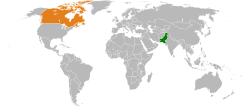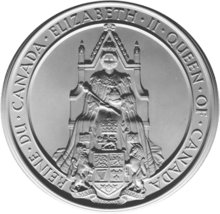Canada–Pakistan relations
Canada–Pakistan relations, or Canadian-Pakistani relations, refers to the bilateral relations between Canada and Pakistan—which are built upon "people-to-people links, governance and democracy, human rights, climate change, development assistance, regional security and defence, transnational crime, and trade and investment."[1] Canada is primarily represented in Pakistan by a high commission in Islamabad, while maintaining a trade office and consulate in Karachi and a consulate in Lahore. Pakistan is represented in Canada by a high commission in Ottawa, and consulates-general in Toronto, Vancouver and Montreal. Both nations are credited on the international stage with significant contributions to United Nations (UN) peacekeeping and are members of the Commonwealth of Nations, owing to their shared history as colonies of the former British Empire. The relationship between the two countries has generally been characterized with stability and mutual cooperation, with Canadian Governor General Roméo LeBlanc making a state visit to Pakistan in 1998. However, relations saw a major negative impact that same year after Pakistan conducted nuclear weapons tests (codenamed Chagai-I) and became an officially declared nuclear weapons state in late May—becoming the 7th country in the world to acquire nuclear weapons technology immediately after India's tests (codenamed Pokhran-II) earlier that month. Canada, along with many other nations, immediately condemned the acquisition of nuclear weapons by both nations, and imposed full sanctions on both India and Pakistan. Relations normalized in the following years and bilateral trade between the two nations stood at C$1.04 billion in 2017.[2] Canada recognizes Pakistan's significance as a important player and major non-NATO ally in regards to combating terrorism globally as well as domestically with the Afghanistan conflict and spillover into Pakistan. Canada was also among the nations that deployed peacekeepers to the Kashmir region in 1949, shortly after the Indo-Pakistani War of 1947-48—and strongly advocates for a peaceful solution to the India-Pakistan conflict over Kashmir. Today, Canada is home to one of the largest Pakistani diasporas, with figures speculated to be at least 215,000 while there are some 30,000—50,000 Canadians in Pakistan.[3]
 | |
Pakistan |
Canada |
|---|---|
Country comparison
| Official Name | Canada | Islamic Republic of Pakistan |
|---|---|---|
| Flag | .svg.png) |
 |
| Coat of Arms / State Emblem |  |
 |
| Population | 37,894,799 (2020 est.)[5] — 38th | 233,500,636 (2020 est.)[6] — 5th |
| Area | 9,984,670 km2 (3,855,100 mi2)[7] — 2nd | 881,913 km2 (340,509 mi2)[8] — 33rd |
| Population Density | 3.92/km2 (10.2/mi2)[9] | 287/km2 (742/mi2)[10] |
| Capital | Ottawa | Islamabad |
| Largest City | Toronto (2,731,571)[11] | Karachi (16,093,786)[12] |
| Government | Federal Parliamentary Constitutional Monarchy | Federal Parliamentary Republic |
| First Leader | John Alexander MacDonald | Muhammad Ali Jinnah |
| Current Leader(s) | Prime Minister Justin Trudeau | Prime Minister Imran Khan |
| Ruling Political Party | Liberal Party of Canada | Pakistan Tehreek-e-Insaf |
| Official Language(s) | English, French | English, Urdu |
| Main Religions | Christianity (68%)
Atheism/Agnosticism (24%) Islam (3%) Hinduism (2%) Sikhism (1%) Buddhism (1%) |
Islam (96%)
Hinduism (2%) Christianity (2%)[14] |
| Ethnic Groups | "Canadian" - Unaffiliated European (32%)
English (18%) Scottish (14%) French (14%) Irish (13%) German (10%) |
Punjabi (45%)
Pashtun (15%) Sindhi (14%) Sariaki (8%) Muhajir (8%) Baloch (4%) |
| Human Development Index (HDI) | 0.922 (very high)[17] — 13th | 0.562 (medium)[18] — 150th |
| Gross Domestic Product (GDP) | US$1.713 trillion (2018)[19] — 10th | US$314.6 billion (2018)[20] — 40th |
| Gross Domestic Product (GDP) | US$1.97 trillion (2020 est.)[21] — 16th | US$1.2 trillion (2020 est.)[22] — 23rd |
| Military Expenditures (US$) | $22.5 billion[23] — 14th | $11.4 billion[24] — 35th |
| Military Strength Ranking
— Worldwide Power Index |
0.3712[25] — 24th
• Non-nuclear weapons state |
0.2364[26] — 15th
• Declared nuclear weapons state |
History
Canada established bilateral relations with the Dominion of Pakistan shortly after the latter's independence from British rule in 1947.[27] When the Indo-Pakistani War of 1947-48 broke out in Kashmir in that same year, Canada strongly expressed the desire for a rapid and peaceful solution to the conflict and was also one of the first few countries to provide United Nations peacekeeping in the volatile region of Kashmir as early as 1949.[28] Throughout Pakistan's history and wars with neighbouring India, Canada has expressed its concern with regards to the stability of the region and repeatedly urged restraint and diplomatic discussion to resolve the Kashmir conflict.[29] Canada has historically and presently remained neutral in all of the Indo-Pakistani wars and standoffs in contrast with the neighbouring United States—which had both directly and indirectly favoured Pakistan due to the latter's alliance with the Western Bloc during the Cold War.
Migration
Migration to Canada from Pakistan has a long history and began as far back when the region was still under British rule. Figures from the 2006 Canadian Census from StatsCan indicate that there are about 124,000 Canadians who claim Pakistani ancestry.[30] There are, however, sources which show the data may be inaccurate and is likely to be more than double this figure. With some sources estimating that the Pakistani Canadian population may be as high as 250,000[31] and the Canadian Government quoting a figure of over 300,000,[32][33] adding that "they continue to make significant contributions to the prosperity and multi-cultural fabric of Canada."[32]
Modern bilateral relations
Canada considers Pakistan an important player and helper in the war against terrorism in the region. The two countries continue to exchange intelligence on essential matters.[34]
See also
- Pakistani Canadian
References
- Canada, Global Affairs (2008-11-20). "Canada - Pakistan Relations". GAC. Retrieved 2020-04-30.
- Canada, Global Affairs (2008-11-20). "Canada - Pakistan Relations". GAC. Retrieved 2020-04-30.
- Hasan, Shazia (2019-08-20). "HC highlights growing ties between Canada, Pakistan". DAWN.COM. Retrieved 2020-04-30.
- This representation of a coat of arms is potentially different from the one used by the armiger (municipality or organisation) in question. This coat of arms was drawn based on its blazon which – being a written description – is free from copyright. Any illustration conforming with the blazon of the arms is considered to be heraldically correct. Thus several different artistic interpretations of the same coat of arms can exist. The design officially used by the armiger is likely protected by copyright, in which case it cannot be used here.
- "Statistics Canada - Population Estimates". Statistics Canada. Retrieved 30 April 2020.
- "Country Comparison :: Population — The World Factbook - Central Intelligence Agency". www.cia.gov. Retrieved 2020-04-25.
- "Statistics Canada - Geography". Statistics Canada. Retrieved 30 April 2020.
- "Where is Pakistan?". WorldAtlas. Retrieved 2020-04-25.
- "Statistics Canada - Population Density". Statistics Canada. Retrieved 30 April 2020.
- "Pakistan Population (2020) - Worldometer". www.worldometers.info. Retrieved 2020-04-25.
- "Statistics Canada - Toronto Population Census 2016". Statistics Canada. Retrieved 30 April 2020.
- "Karachi Population 2020 (Demographics)". worldpopulationreview.com. Retrieved 2020-04-25.
- "Major Religions of Canada". WorldAtlas. Retrieved 2020-04-30.
- "Religion in Pakistan". WorldAtlas. Retrieved 2020-04-25.
- "Major Ethnic Groups of Canada". WorldAtlas. Retrieved 2020-04-30.
- "Ethnic Groups In Pakistan". WorldAtlas. Retrieved 2020-04-25.
- "2019 Human Development Index Ranking | Human Development Reports". hdr.undp.org. Retrieved 2020-04-30.
- "| Human Development Reports". hdr.undp.org. Retrieved 2020-04-25.
- "World Development Indicators - Google Public Data Explorer". www.google.com. Retrieved 2020-04-30.
- "World Development Indicators - Google Public Data Explorer". www.google.com. Retrieved 2020-04-25.
- "Report for Selected Countries and Subjects". www.imf.org. Retrieved 2020-04-30.
- "Report for Selected Countries and Subjects". www.imf.org. Retrieved 2020-04-25.
- "2020 Canada Military Strength". www.globalfirepower.com. Retrieved 2020-04-30.
- "Data for all countries from 1988–2018 in constant (2017) USD (pdf)" (PDF). STOCKHOLM INTERNATIONAL PEACE RESEARCH INSTITUTE. 2017–2018. Retrieved 25 April 2020.CS1 maint: date format (link)
- "2020 Canada Military Strength". www.globalfirepower.com. Retrieved 2020-04-30.
- "2020 Pakistan Military Strength". www.globalfirepower.com. Retrieved 2020-04-25.
- Canada, Global Affairs (2008-11-20). "Canada - Pakistan Relations". GAC. Retrieved 2020-04-30.
- Wood, James. "Canadian Army".
- Defence, National (2019-06-03). "India - Pakistan 1965". aem. Retrieved 2020-04-30.
- "2006 Census of Canada: Topic-based tabulations | Ethnic Origin (247), Single and Multiple Ethnic Origin Responses (3) and Sex (3) for the Population of Canada, Provinces, Territories, Census Metropolitan Areas and Census Agglomerations, 2006 Census - 20% Sample Data". 2.statcan.ca. 2010-12-07. Retrieved 2011-01-22.
- "Archived copy" (PDF). Archived from the original (PDF) on 2013-01-22. Retrieved 2014-06-06.CS1 maint: archived copy as title (link)
- "Canada-Pakistan Relations". Canadainternational.gc.ca. 2009-07-03. Archived from the original on 2013-05-10. Retrieved 2011-01-22.
- "Canadian- Pakistani Diversity Professor Advocates for Equity". Allvoices.com. 2010-03-30. Archived from the original on 2011-07-26. Retrieved 2011-01-22.
- Government of Canada, Foreign Affairs Trade and Development Canada. "Canada - Pakistan Relations". GAC.
External links
- High Commission of Canada to Pakistan
- Pakistan High Commission Ottawa
- From Islamabad to the Swat Valley by Caitlin Manicom, a former resident with the Canadian embassy in Pakistan
